-
Jaguar Traders Ltd. was incorporated on 4 May 1998 with a nominal capital of Sh.
1,000,000 divided into 50,000 ordinary shares of Sh.20 each.
On 5 May...
(Solved)
Jaguar Traders Ltd. was incorporated on 4 May 1998 with a nominal capital of Sh.
1,000,000 divided into 50,000 ordinary shares of Sh.20 each.
On 5 May 1998, the directors invited interested members of the public to apply for purchase of
shares at par. The closing date for application was 15 May 1998. Applications were received for
60,000 ordinary shares and paid in full. The allotment was made on 20 May 1998 and the excess
application money refunded.
On 26 May 1998, the directors bought: furniture Sh. 150,000, equipment Sh.250,000
and goods Sh.500,000. All these were delivered and paid for on the same date.
Required:
(a) Journal entries, including bank to record the above transactions
(b) Ledger accounts
(c) Balance sheet as at 26 May 1998
Date posted:
November 25, 2018
.
Answers (1)
-
The following is the bank statement of Kakamega Retail Traders for the month of October 1996:
(Solved)
The following is the bank statement of Kakamega Retail Traders for the month of October 1996:
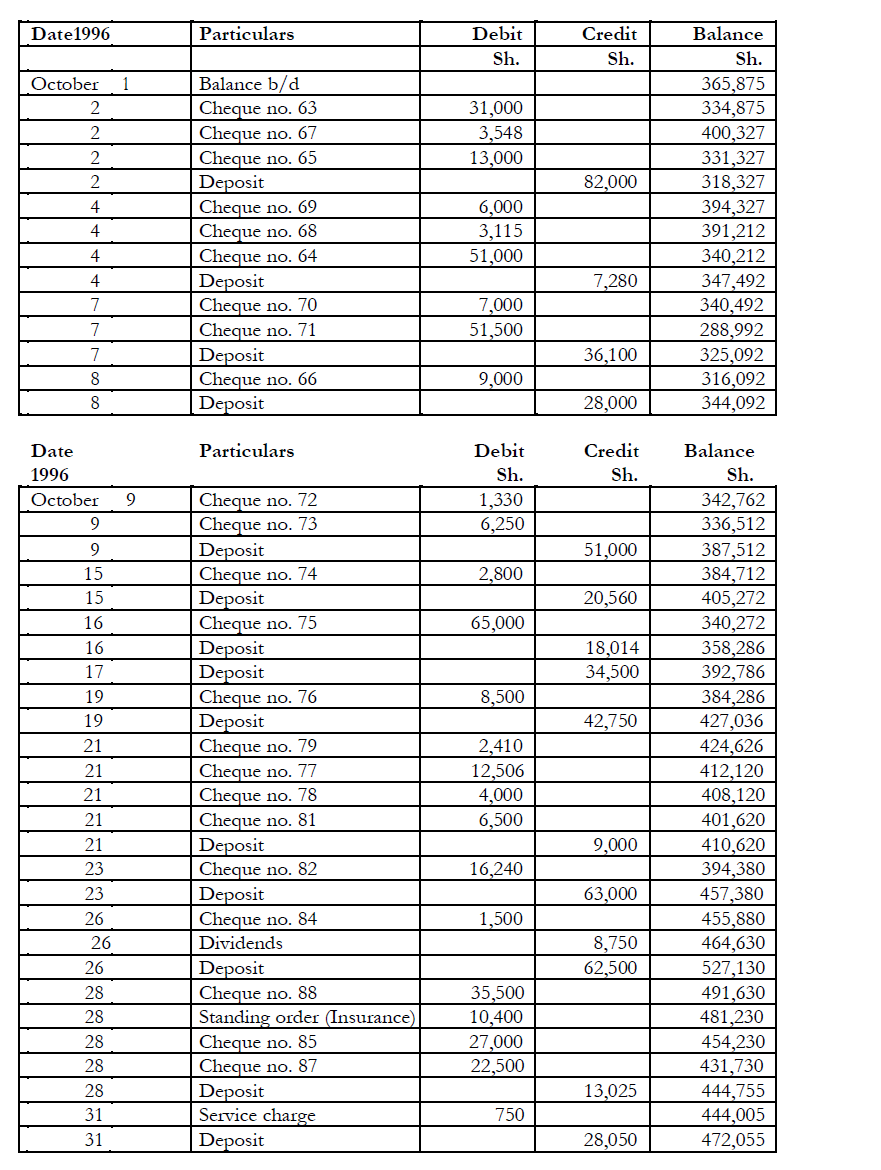
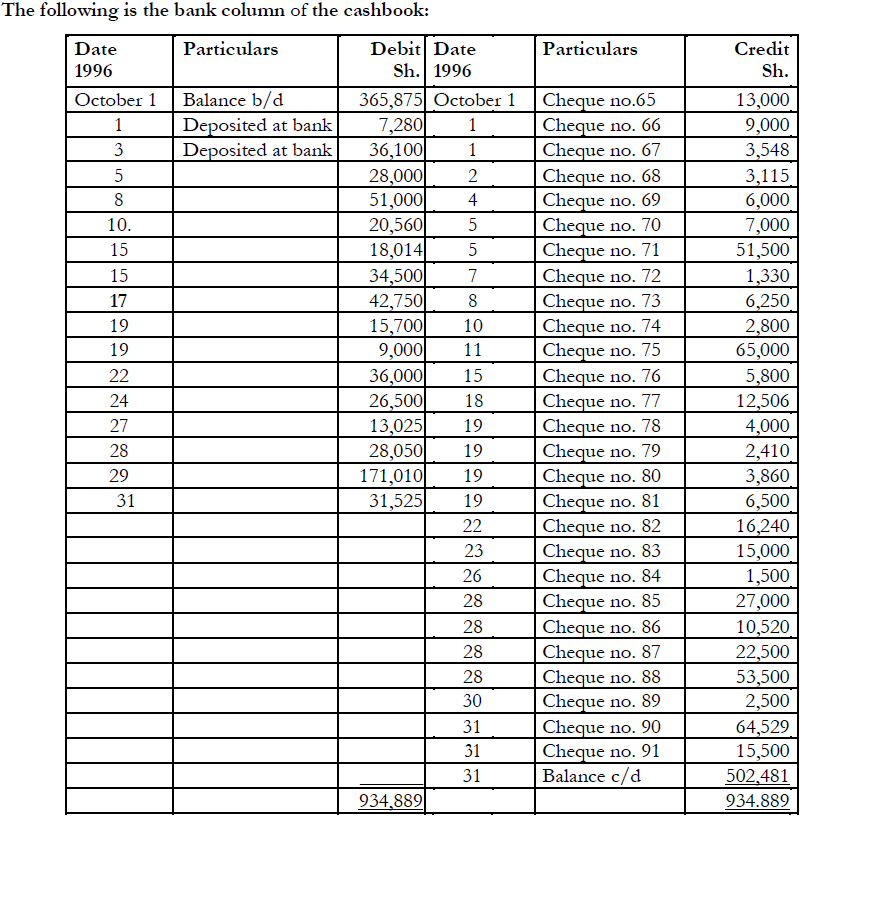
Notes:
1. The bank reconciliation on 30 September 1996 showed that one deposit was in transit and
two cheques had not yet been presented to the bank.
2. Deposits of Sh.62, 500 and Sh.36, 000 had been entered in the cash book as Sh.26,500
and Sh.36,000 and in the bank statement as Sh.62,500 and Sh.63,000, respectively.
3. A cheque from Mkulima for Sh.15,700 was deposited on 18 October 1996 but
was dishonoured and the advice was received on 4 November 1996.
4. Counterfoils for cheques no. 76 and no. 88 showed they had been drawn for Sh.5,800 and
Sh.35,500 respectively.
Required:
(a) A correct cashbook balance.
(b) A bank reconciliation statement on 31 October 1996.
Date posted:
November 25, 2018
.
Answers (1)
-
What is the purpose of preparing a bank reconciliation statement?
(Solved)
What is the purpose of preparing a bank reconciliation statement?
Date posted:
November 25, 2018
.
Answers (1)
-
The treasurer of Kay Club and Ray Society has prepared the following receipts and payments
account for the year ended 31 December 1994:
(Solved)
The treasurer of Kay Club and Ray Society has prepared the following receipts and payments
account for the year ended 31 December 1994:
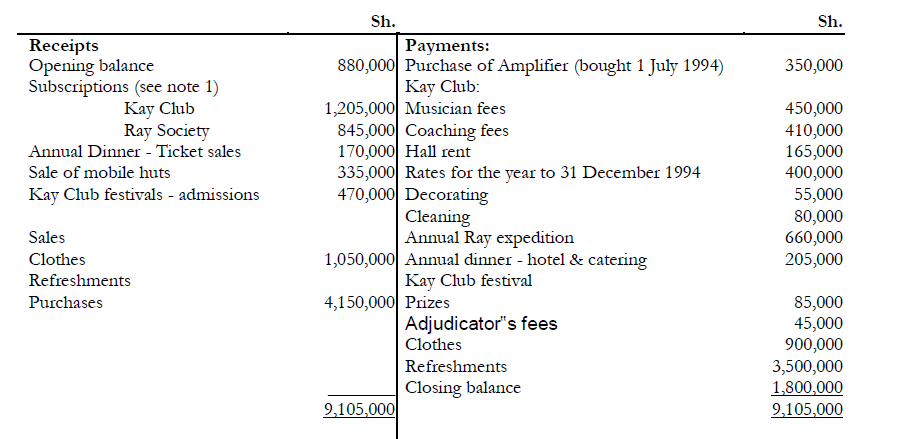
Note. It is the policy of the Society NOT to take into account subscriptions in arrear until
theyare paid.
1) The mobile hut which was sold during 1994 had been valued at Sh.400,000 on 31
December 1993, and was used for the society's activities until sold on 30 June 1994.
2) Immediately after the sale of the mobile hut, the Society rented a new hall at Sh.165,000 per
annum.
3) The above receipts and payments account is a summary of the society's bank account for
the year ended 31 December 1994; the opening and closing balances shown above were the
balances shown in the bank statements on 31 December 1993 and 1994 respectively.
4) All cash is banked immediately and all payments are made by cheque.
5) A cheque for Sh.l00,000 drawn by the society on 28 December 1994 for stationery was not
paid by the bank until 4 January 1995.
6) The Society's assets and liabilities at 31 December 1993 and 1994, in addition to those
mentioned earlier, were as follows:

Required:
a) The Society's Income and Expenditure Account for the year ended 31 December
1994, and balance sheet as at that date. (Comparative figures are not required).
b) Outline the advantages of income and expenditure accounts as compared with
receipts and payments accounts.
Date posted:
November 25, 2018
.
Answers (1)
-
Manga Munene is the proprietor of a retail business, which has two main departments, which
sell hardware and electrical goods, respectively. He had previously prepared his...
(Solved)
Manga Munene is the proprietor of a retail business, which has two main departments, which
sell hardware and electrical goods, respectively. He had previously prepared his annual accounts
in such a way that the relative profitability of the two departments was not ascertainable, but
now he wishes to attempt to identify the profit attributable to each department in order that he
may pay a bonus to the more successful of the departmental managers. At 30 September 1994,
the balances in the books of the business were as follows:
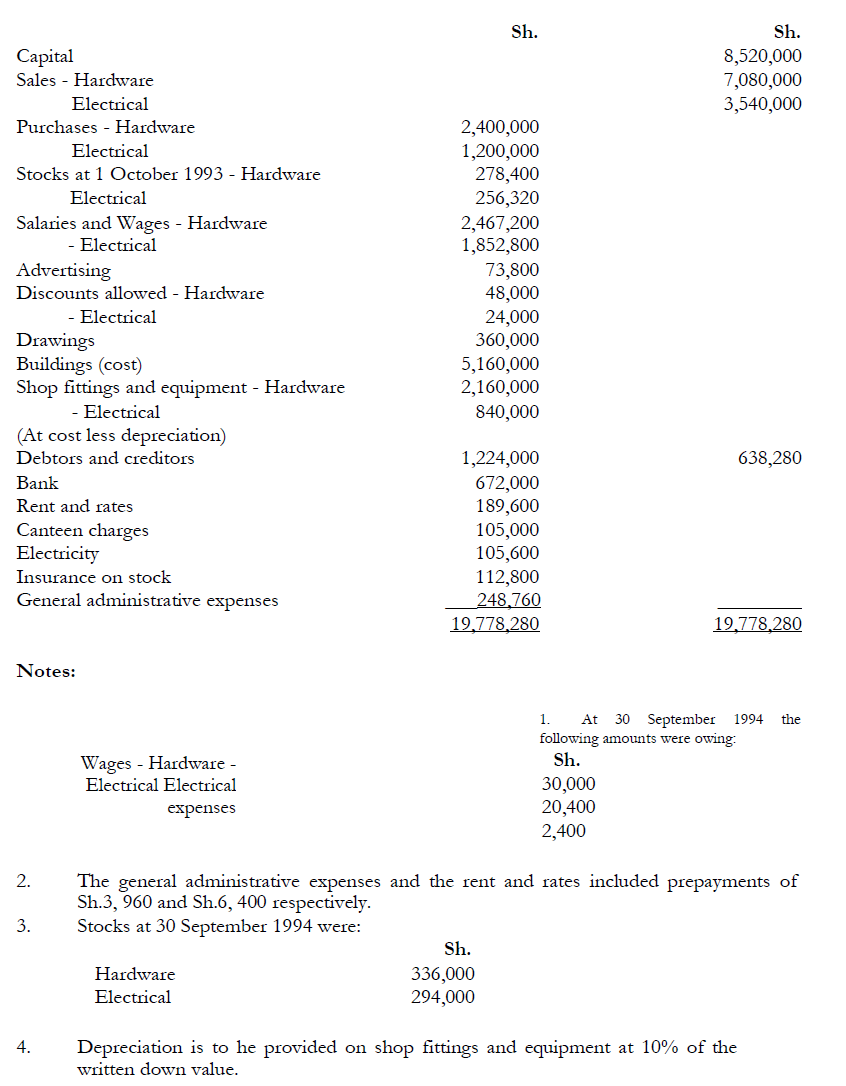

The general administrative expenses are primarily incurred in relation to the processing
of purchases and sales invoices.
Required:
(a) A schedule showing the basis on which you have apportioned the various expenses
between the two departments.
(b) The departmental and combined Trading and Profit and Loss Account for the year
ended 30 September 1994.
(c) Balance Sheet at 30 September 1994.
Date posted:
November 25, 2018
.
Answers (1)
-
The following trial balance was extracted from the books of Hiza Ltd. as on 30 September 1995
(Solved)
The following trial balance was extracted from the books of Hiza Ltd. as on 30 September 1995:
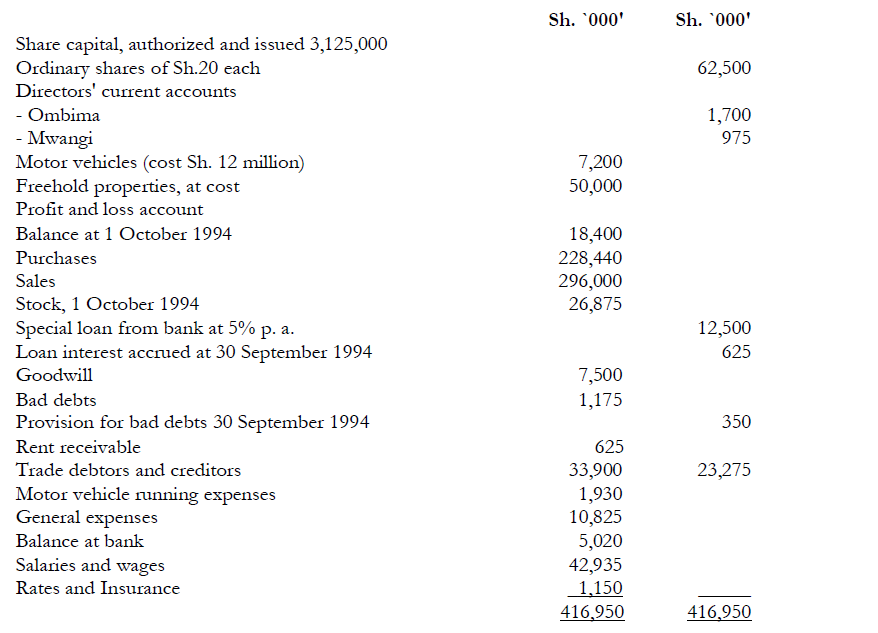
You are given the following information:
1. Stock in trade, 30 September 1995 was Sh.28, 875,000.
2. The provisions for bad debts is to be increased to Sh.750,000.
3. Salaries and .wages outstanding at 30 September 1995 is Sh.500,000.
4. Rates and insurance paid in advance at 30 September 1995 is Sh. 155,000.
5. The item 'rent receivable Sh.625,000 includes Sh. 125,000 in respect of the period from 1
October 1995 to 31 December 1995.
6. Provision is to be W de for depreciation of motor vehicles at the rate of 20 per cent
per annum on cost.
7. During the year to 30 September 1995, Ombima, one of the directors took goods (cost
Sh.437,500) out of business stock for his own use. No entry for this transaction has
been made in the books.
Required:
(a) Trading and Profit and Loss Account for the year to 30 September 1995.
(b) Balance Sheet as at that date.
Date posted:
November 25, 2018
.
Answers (1)
-
With reference to International Accounting Standards explain the following:
(a) Fundamental accounting concepts
(b) Accounting bases
(c) Accounting policies
(Solved)
With reference to International Accounting Standards explain the following:
(a) Fundamental accounting concepts
(b) Accounting bases
(c) Accounting policies
Date posted:
November 25, 2018
.
Answers (1)
-
James Mbuvi started a taxi business in Nairobi in March 1990 under the firm name Mbuvi
Taxis. The firm had two vehicles KA and KB which...
(Solved)
James Mbuvi started a taxi business in Nairobi in March 1990 under the firm name Mbuvi
Taxis. The firm had two vehicles KA and KB which had been purchased for Sh.560,000 and
Sh.720,000 respectively earlier in the year.
In February 1992 vehicle KB was involved in an accident and was written off. The insurance
company paid the firm Sh.160,000 for the vehicle. In the same year the firm purchased two
vehicles, KC and KD for Sh.800,000 each.
In November 1993' vehicle KC was sold for Sh.716,000. In January 1994 vehicle KE was
purchased for Sh.840,000. In March 1994 another vehicle KF was purchased for Sh.960.000.
The firm's policy is to depreciate vehicles at the rate of 25 per cent on cost on vehicles on hand
at the end of the year irrespective of the date of purchase. Depreciation is not provided for
vehicles disposed of during the year. The firm's year ends on 31 December.
Required:
(a) Calculate the amount of depreciation charged in the profit and loss account for each of the five
years.
(b) Prepare the motor vehicle account (at cost).
(c) Calculate the profit or loss on disposal of each of the vehicles disposed of by the company.
Date posted:
November 25, 2018
.
Answers (1)
-
According to the cash hook of Gaitani Ltd. the company has a credit balance at the hank of
Sh.190.000 on 30 June 1994, but this is...
(Solved)
According to the cash hook of Gaitani Ltd. the company has a credit balance at the hank of
Sh.190.000 on 30 June 1994, but this is NOT borne out by the Bank Statement of the same
date. An investigation into the difference yields the following information.
1 A standing order for a charitable subscription of Sh.20, 000 had been paid by the
hank on 29 June but no entry had been made in the cash hook.
2. A cheque paid for advertising on 10 little for Sh.89,500 had been entered into
the cash hook as Sh.98,500.
3 Cheques for S11.5 18,500 sent to creditors on 30 June were not paid by the hank
until 8 July.
4. Cheques received front customers amounting to sh.840.000 were paid into the bank on
30 June but were not credited by the hank until 5 July.
5. On 20 Julie a cheque for h.57, 000 was received from a customer in settlement of
an invoice for Sh.60.000. An entry of Sh.60.000 had been made in the cash hook.
Required:
(a) Prepare a statement reconciling the cash hook balance with the hank statement.
(b) Explain how a company may have reduced its hank balance during an accounting period
but still have earned a profit fur that same period.
Date posted:
November 25, 2018
.
Answers (1)
-
The Chief Accountant of KK Ltd. has extracted the following trial balance as at 31 October 1998:
(Solved)
The Chief Accountant of KK Ltd. has extracted the following trial balance as at 31 October 1998:
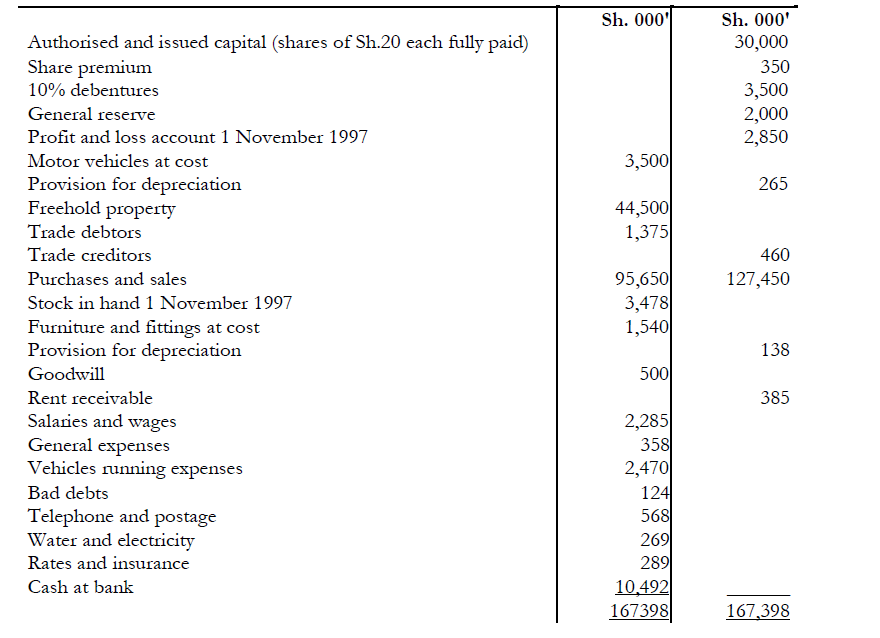
Notes:
1. Credit sales amounting to Sh. 165,000 were made on 31 October 1998 but no entries were
made in the books.
2. Returns outwards amounting to Sh. 128,000 were dispatched on 31 October 1998 but no
entries were made in the books.
3. Closing stock was valued at Sh.4, 398,000.
4. Accrued salaries and telephone bills amounted to Sh. 134,000 and Sh.55, 000 respectively.
5. Rent for the month of October 1998 amounting to Sh.35, 000 had not been received
from the tenant.
6. Provision for depreciation on furniture and fittings and the motor vehicles are 10% and
20% on cost respectively.
7. Provision for bad and doubtful debts of 5 % on trade debtors should be made.
8. Corporation tax should be provided at 35 % of the net profit before tax.
9. The directors propose a dividend of 15% on issued share capital and a transfer of
Sh.2, 500,000 to the general reserve.
10. The debenture interest has not yet been paid.
Required:
(a) Trading, profit and loss account for the year ended 31 October 1998.
(b) Balance sheet as at 31 October.
Date posted:
November 25, 2018
.
Answers (1)
-
List and explain five characteristics of a partnership
(Solved)
List and explain five characteristics of a partnership.
Date posted:
November 24, 2018
.
Answers (1)
-
Accounting Ratios have been used by a number of companies as indicators of their financial performance in the present and even in the future. Discuss...
(Solved)
Accounting Ratios have been used by a number of companies as indicators of their financial performance in the present and even in the future. Discuss the five limitations associated with their use for this purpose.
Date posted:
November 24, 2018
.
Answers (1)
-
Kathryn Rochford keeps her petty cashbook on the imprest system, the imprest being Sh.25. For the month of April 20X9 her petty cash transactions were...
(Solved)
(a) Kathryn Rochford keeps her petty cashbook on the imprest system, the imprest being Sh.25. For the month of April 20X9 her petty cash transactions were as follows:

(i) Enter the above transactions in the petty cashbook and balance the petty
cashbook at 30 April, bringing down the balance on 1 May.
(ii) On 1 May Kathryn Rochford received an amount of cash from the cashier
to restore the imprest. Enter this transaction in the petty cashbook.
(b) Open the ledger accounts to complete the double entry for the following:
(i) The petty cash analysis columns headed Postage and Stationery and Travelling Expenses;
(iii) The transactions dated 9 and 23 April 20X9.
Date posted:
November 24, 2018
.
Answers (1)
-
Why do some businesses keep a petty cashbook as well as a cashbook?
(Solved)
Why do some businesses keep a petty cashbook as well as a cashbook?
Date posted:
November 24, 2018
.
Answers (1)
-
The directors of Hawk, a limited liability company, wish to compare the company's most recent financial statements with those of the previous year. The company's...
(Solved)
The directors of Hawk, a limited liability company, wish to compare the company's most recent financial statements with those of the previous year. The company's financial statements are given below:
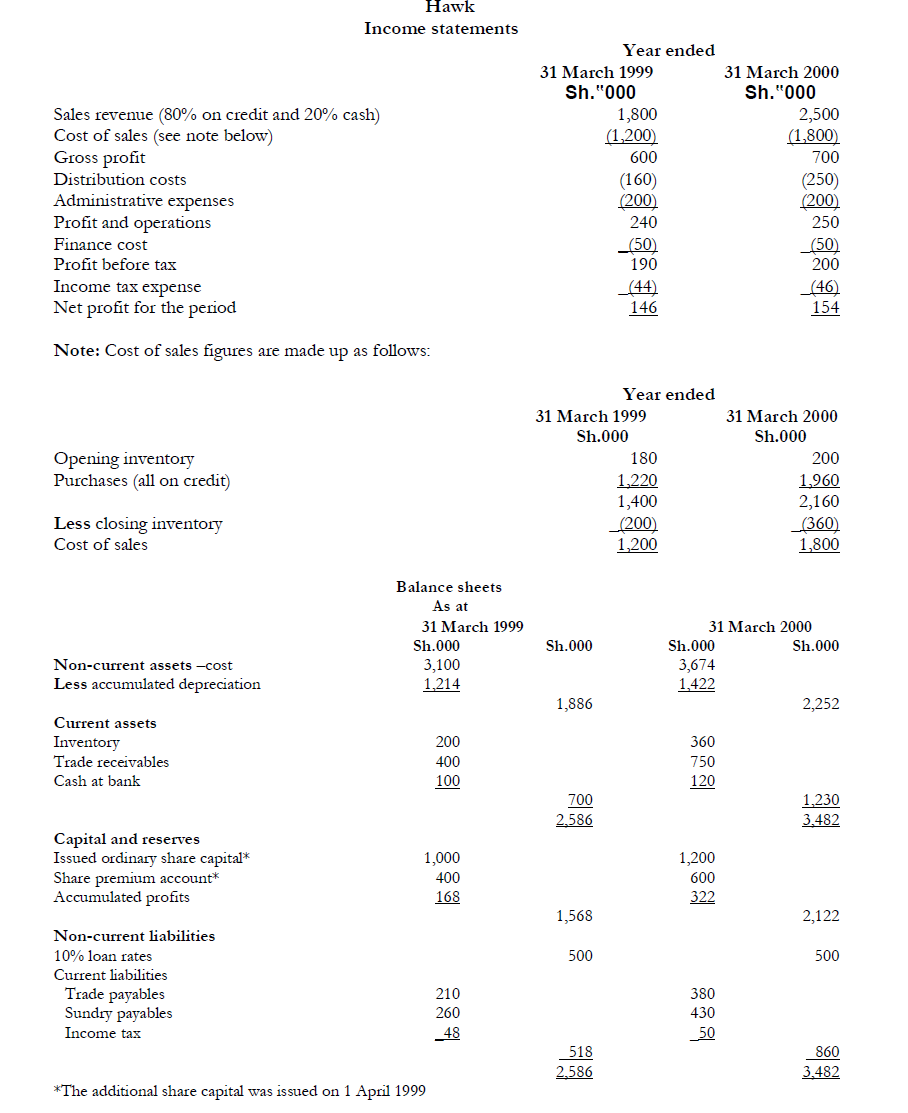
Required:
(a) Calculate, for each of the two years, eight accounting ratios which should assist the directors
in their comparison, using closing figures for balance sheet items needed.
(b) Suggest possible reasons for the changes in the ratios between the two years.
Date posted:
November 24, 2018
.
Answers (1)
-
Orion and Pegasus are two sole traders who decide to amalgamate their businesses into
a partnership as from 1 January 2001.
Their balance sheets at 31 December...
(Solved)
Orion and Pegasus are two sole traders who decide to amalgamate their businesses into
a partnership as from 1 January 2001.
Their balance sheets at 31 December 2000 are as follows:
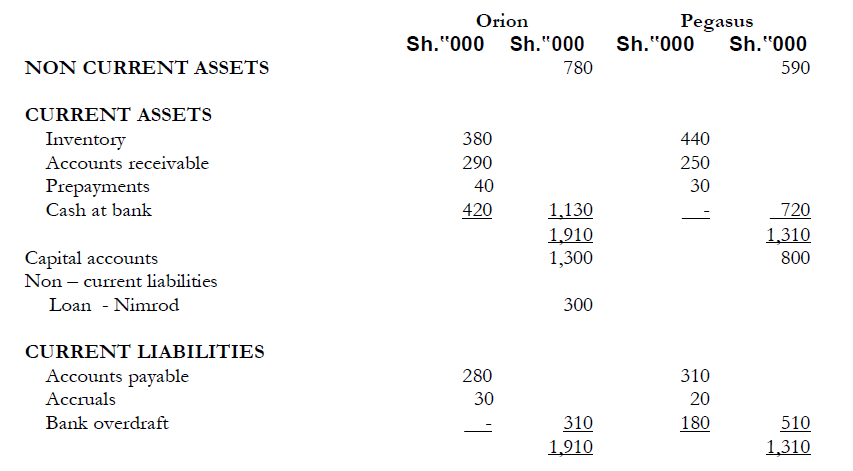
(1) Goodwill, which does not appear in the records of either business, is valued at:
Sh.‟000
Orion 200
Pegasus 180
Goodwill is not to appear in the opening balance sheet of the partnership.
(2) Profit-sharing ratios in the partnership are agreed as :
Orion 60%
Pegasus 40%
(3) Land included in Orion.s non-current assets at Sh.100,000 to be revalued to Sh.130,000.
(4) Orion and Pegasus did not transfer their motor cars to the new business but retained
them personally. The motor cars are currently included in their non-current assets at
their book value as follows:
Sh.‟000
Orion 18
Pegasus 16
(5) Orion's loan from Nimrod was repaid by Orion on 31 December 2000.
(6) The remaining balance of Orion's cash, and the overdraft of Pegasus,
were combined into a single bank account for the partnership.
(7) All other assets and liabilities of the businesses were brought into the partnership at
their stated book value.
Required:
(a) Show the capital accounts of the two traders to record the closure of their businesses.
(b) Prepare the opening balance sheet of the new partnership of Orion and Pegasus as at 1
January 2001.
(c) Explain why asset revaluations and a goodwill adjustment may be needed when a partner
retires or dies, a new partner is admitted or there is a change in profit-sharing ratios.
Date posted:
November 24, 2018
.
Answers (1)
-
Cygnus is a sole trader selling antiques from a rented shop. He has not kept proper
accounting records for the year ended 31 January 2001, in...
(Solved)
Cygnus is a sole trader selling antiques from a rented shop. He has not kept proper
accounting records for the year ended 31 January 2001, in spite of his accountant‟s advice
after the preparation of his accounts for the year ended 31 January 2000.
His assets and liabilities at 31 January 2000 and 31 January 2001 were as follows:
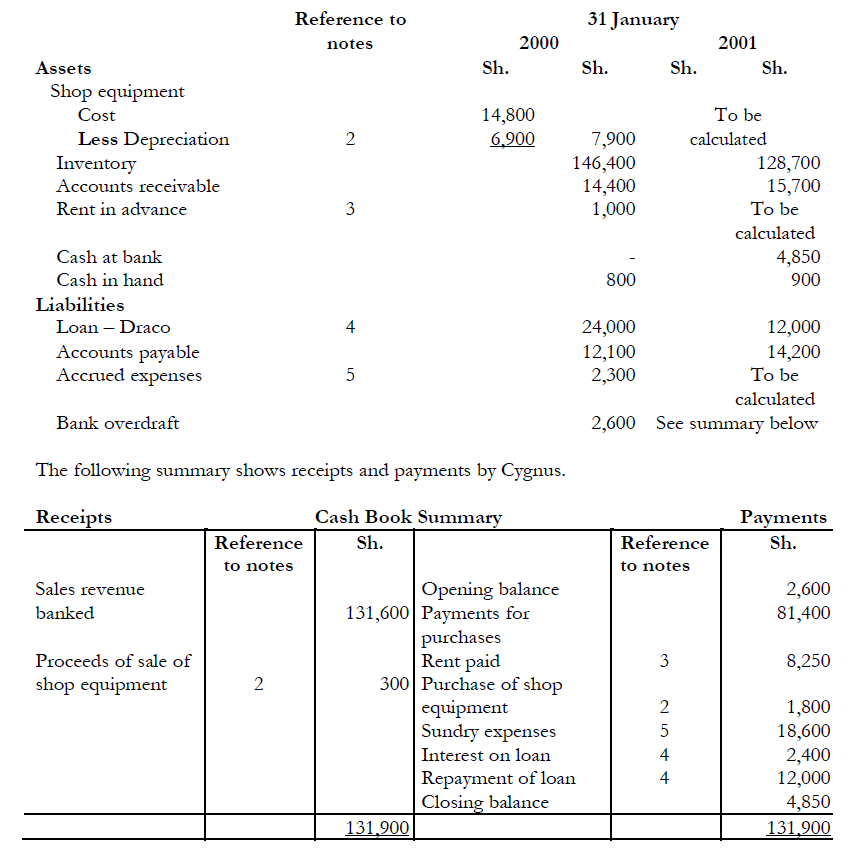
Before banking the shop takings, Cygnus took various amounts as drawings.
Notes
(1) Cygnus fixes his selling prices by doubling the cost of all items purchased.
(2) During the year, Cygnus sold for Sh.300 equipment that had cost Sh.800, and had a
written down value at 1 February 2000 of Sh.200. He purchased further equipment on
1 August 2000 for Sh.1,800.
(3) Depreciation is charged at 10% per year on the straight-line basis, with no
depreciation in the year of sale and proportionate depreciation in the year of purchase.
(4) Rent is payable quarterly in advance on 1 January, 1 April, 1 July and 1 October
each year. On 1 July 2000, the annual rent was increased from Sh.6,000 to Sh.9,000.
(5) The loan from Draco carries interest at 10% per year payable annually on 31
December. On 31 December 2000, Cygnus repaid Sh.12,000 of the loan. The balance is
repayable on 31 December 2004.
(6) The accrued expenses at 31 January 2000 consist of the Sh.200 interest accrued
on Draco.s loan (see Note 4) and sundry expenses of Sh.2,100. At 31 January
2001, accruals for sundry expenses amounted to Sh.3,300.
Required:
(a) Prepare for Cygnus an income statement for the year ended 31 January 2001 and a
balance sheet as at that date.
Date posted:
November 24, 2018
.
Answers (1)
-
Briefly explain the following accounting Concepts. (i) Going concern (ii) Accruals (iii) Consistency (iv) Prudence or conservatism (v) Materiality
(Solved)
i) Going concern
ii) Accruals
iii) Consistency
iv) Prudence or conservatism
v) Materiality
vi) Substance over form
vii) Business entity concept
viii) Money measurement
ix) Historical cost
x) Objectivity
xi) Realization
xii) Duality
Date posted:
November 24, 2018
.
Answers (1)
-
What are accounting concepts, Bases, Policies?
(Solved)
What are accounting concepts, Bases, Policies?
Date posted:
November 24, 2018
.
Answers (1)
-
Mr. James Bulayi formed Malimia Traders, a sole proprietorship five years ago. His initial capital
injection was Sh.1,000,000 cash. For a number of years, Bulayi's wife...
(Solved)
Mr. James Bulayi formed Malimia Traders, a sole proprietorship five years ago. His initial capital
injection was Sh.1,000,000 cash. For a number of years, Bulayi's wife maintained the accounting
records, but early in 1993 she became seriously ill. Mr. Bulayi consulted a CPA firm whose
manager told him "you keep a record of your cash receipts and payments and a list of your
assets and liabilities, at the beginning and end of the year, and I will prepare financial statements
for you at the end of the year".
On 31 October 1993, Mr. Bulayi presented the following data to the Manager of the CPA firm.
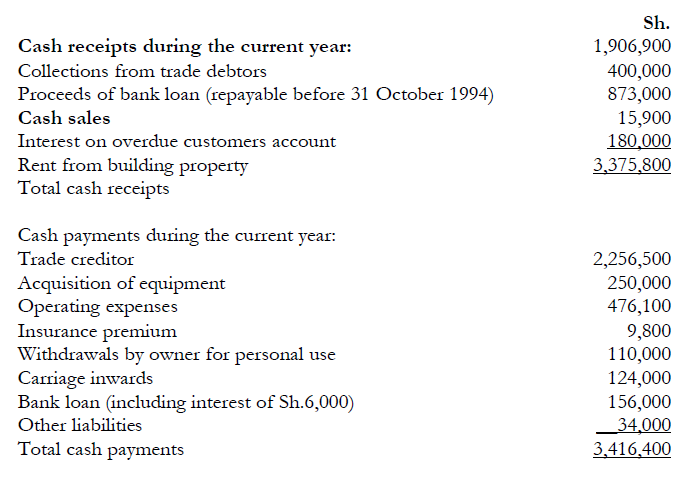
Additional information:
i) Although the primary source of revenue is from trading Malimia Traders also earns income
from rent and interest. Malimia Trader conducts business from the ground floor of its twofloor
storey building. The first floor is rented to a shoe-retailer for a monthly rent. The
retailer pays 6 months rent in advance on 1 March and 1 September every year. Malimia
Traders increased rent from Sh.15,000 per month to Sh.20,000 per month with effect from
1 September 1993. Malimia Traders charges interest on overdue customers accounts, which
customers usually pay together with the principal amount due. Interest owing by customers
on 31 October 1993 was Sh.5,000.
ii) The following balances of assets and liabilities were extracted on 31 October 1992
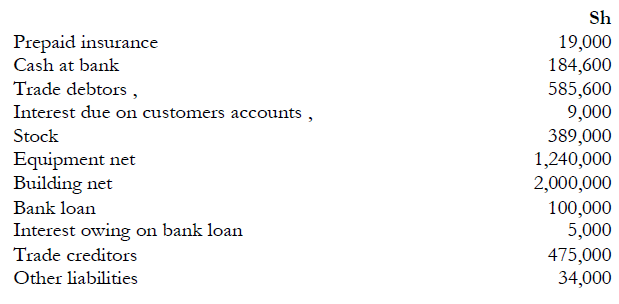
iii) Sh.14,000 of debts had been written off during the accounting period, of which Sh.8,500
was from sales of the previous accounting year, Bulayi estimated that Sh.14,200 of the 31
October 1993 debtors balances may be uncollectable and a provision is required.
iv) Returns inwards and returns outward all applicable to current year's sales and purchases are
Sh.60,000 and Sh.50,000 respectively.
v) Cash discount taken by credit customers in the year are Sh.41,300 discounts on purchases
are Sh.64,000.
Depreciation is to be provided on reducing balance on fixed assets held at year end at the
rate of 5% per annum on building and 25% per annum on equipment. There were no
disposals of plant assets during the year.
Interest owing on the bank loan at 31 October 1993 is Sh.17,500. The amount paid for
insurance includes a premium of Sh 8,000 paid to cover the firm against fire for the Co. six
months to 31 January 1994.
Stock in hand on 31 October 1993 was valued at Sh985,000.
On 31 October 1993 the amounts owing to suppliers was Sh.523,000 and the amount
owing by customers was Sh,663,2000 (excluding interest on overdue accounts). All
purchases of stock are on credit.
Ground rent and land rates for the year amounted to Sh.50,000 The bills received in
respect of the two are not yet paid.
Required:
Malimia Traders' Trading, Profit and loss Account for the year ended 31 October 1993 and a
Balance Sheet as at that date.
Date posted:
November 24, 2018
.
Answers (1)